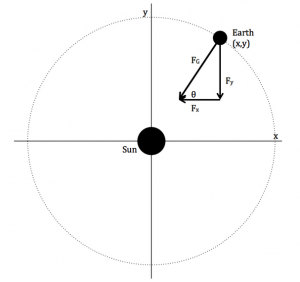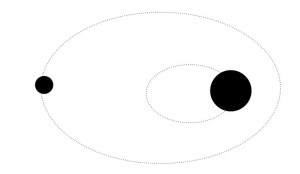We plan on modeling objects in orbital motion, namely the sun and earth, the earth and moon, the three together, and finally an orbit of two large-massed bodies, such as the sun and another star.
The programming steps we need to take are straightforward in theory. We have already settled on using the Euler-Cromer method on MatLab to simulate the motion. We have access and prior knowledge of Newton’s laws and Kepler’s laws of motion, as shown below. The potentially difficult part will be writing a program that will be able to track the motion of several bodies simultaneously, with the capability of visualization, such as a moving graphic.
(1) ![]()
where Ms is the mass of the sun and Me is the mass of the earth.
Kepler’s Laws:
- All planets move in elliptical orbits with the Sun at one focus.
- The line joining a planet to the Sun sweeps out equal areas in equal times.
- If T is the period and a the semimajor axis of the orbit, then T^2/a^3
(2) ![]()
(3) ![]()
from which we can derive the equation:
(4) ![]()
for the x-direction. A similar equation can be found for the y-direction. For the equations of motion that will be put into the Euler-Cromer program, we will use equations similar to those derived in Giordano.
(5) ![]()
(6) ![]()
(7) ![]()
(8) ![]()
For preliminary data, we hope to have a primitive program that has the capability of simulating a simple Earth-Sun orbit, assuming that the Sun is so massive (compared to Earth) that it does not move. We hope to have an appropriate visualisation, a moving plot, to apply to the data. At this time we will need to heavily research the physics of the situation, including providing details of what is physically incorrect about our simulation and the amount of error these details create. The defense of this simulation, including pros and cons of the Euler-Cromer method in this case, will be in the preliminary data.
The second goal is to make the system more complicated, either adding the moon or another planet to the existing system. As in the first set of data, we will need to analyze it for flaws. We anticipate this to be the most difficult programming challenge, as there are three systems moving simultaneously, and also the most complex error analysis.

Finally, we plan to model a system in which each mass is in motion, for example, two large suns or a star and a large planet. At this point, we will be fairly comfortable with the Euler-Cromer method applied to this system. Here, we will truly analyze the flaws with the method and compare and contrast these flaws, and its strengths, with other methods we have learned in class. This will also provide insight into our previous simulations and their errors, as the sun is not un-moving as we assume previously.
We hope the final program will appear similar to the ones shown in Giordano and the exploration of orbits done by Moler.
Timeline:
Week 1: Research more equations and pseudo codes that relate to our simulation.
Week 2: Write a primitive program to simulate the earth and the sun orbit. Calculate error.
Week 3: Finish Earth-Sun simulation. Begin writing program for Moon-Earth-Sun by working with program from Week 2. Begin writing primitive program for two massive planets or stars.
Week 4: Finish program for two massive planets or stars. Calculate error. Troubleshoot Moon-Earth-Sun program.
Week 5: Finish all programs and prepare for presentations.
Resources
- Giordano. Computational Physics, 2006.
- Moler, Cleve. “Orbits,” MathWorks Inc, 2011.



Nice article , wow I never knew calculate the distance to the Earth orbit the sun, superb
– Use Latex to represent equations.
– Make sure that text and figures are of high quality and readable.
– Do not publish anyone else’s figure(s). You may put links to other sites.
– Your work must original; i.e., not a reproduction of someone else’s work.